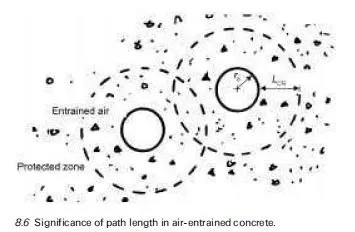The alkali-carbonate reaction occurs between alkali hydroxides and certain argillaceous dolomitic limestones; these dolomites are characterized by a matrix of fine calcite and clay minerals with scattered dolomite rhombohedra. The reaction is manifested by the rapid expansion and extensive cracking of concrete, and structures affected by ACR usually show cracking within five years or less.
Although there is a lack of consensus regarding the precise mechanisms involved, it is generally agreed that the reaction is accompanied by the dedolomitization process, as follows:
![]()
where R represents K or Na. However, since this reaction results in a reduction in solid volume, the expansion must be attributed to an alternative mechanism. Several theories have been proposed for the expansion mechanism (Swenson and Gillott 1964; Tang et al., 1987; Fournier and Berube, 2000) and include:
· hydraulic pressures caused by the migration of water molecules and alkali ions into the restricted spaces of the calcite/clay matrix around the dolomite rhombs
· adsorption of alkali ions and water molecules on the surfaces of the `active’ clay minerals scattered around the dolomite grains and
· growth and rearrangement of the products of dedolomitization (i.e., brucite and calcite).
The alkali carbonate produced in the dedolomitization reaction may react with lime in the cement paste as follows:
![]()
thereby `regenerating’ alkalis for further reaction. Thus, provided sufficient alkali is available to initiate the reaction, the process may continue indepen- dently of the amount of alkalis available in the concrete. This could explain why low-alkali cements are not effective in controlling damaging reaction in some cases.


